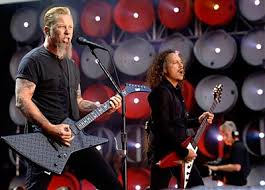 arly heavy metal and hard rock bands such as Black Sabbath, Deep Purple, Led Zeppelin and Scorpions, New Wave of British Heavy Metal bands such as Venom, Motörhead, Diamond Head, Judas Priest, and Iron Maiden, and early Punk Rock bands such as The Ramones, The Sex Pistols, and The Misfits, early Metallica releases contained fast tempos, harmonized leads, and nine-minute instrumentals. Steve Huey of Allmusic said that Ride the Lightning featured "extended, progressive epics; tight, concise groove-rockers". Huey felt Metallica expanded its compositional technique and range of expression to take on a more aggressive approach in following releases, and lyrics dealt with more personal and socially conscious issues.Lyrical themes explored on Master of Puppets included religious and military leaders, rage, insanity, monsters, and drugs.
arly heavy metal and hard rock bands such as Black Sabbath, Deep Purple, Led Zeppelin and Scorpions, New Wave of British Heavy Metal bands such as Venom, Motörhead, Diamond Head, Judas Priest, and Iron Maiden, and early Punk Rock bands such as The Ramones, The Sex Pistols, and The Misfits, early Metallica releases contained fast tempos, harmonized leads, and nine-minute instrumentals. Steve Huey of Allmusic said that Ride the Lightning featured "extended, progressive epics; tight, concise groove-rockers". Huey felt Metallica expanded its compositional technique and range of expression to take on a more aggressive approach in following releases, and lyrics dealt with more personal and socially conscious issues.Lyrical themes explored on Master of Puppets included religious and military leaders, rage, insanity, monsters, and drugs. In 1991, with new producer Bob Rock, Huey felt Metallica simplified and streamlined its music for a more commercial approach to appeal to the mainstream audience. The band abandoned its aggressive, fast tempos to expand its music and expressive range, said Robert Palmer of Rolling Stone. The change in direction proved commercially suc cessful as Metallica was the band's first album to peak at number one on the Billboard 200. Metallica noticed changes to the rock scene created by the grunge movement of the early 1990s. In what has been described as "an almost alternative [rock]" approach, the band focused on non-metal influences and changed musical direction. Moving away from lyrical themes dealing with drugs and monsters, Metallica's new lyrical approach focused on anger, loss, and retribution. Some fans and critics were not pleased with this change, w
cessful as Metallica was the band's first album to peak at number one on the Billboard 200. Metallica noticed changes to the rock scene created by the grunge movement of the early 1990s. In what has been described as "an almost alternative [rock]" approach, the band focused on non-metal influences and changed musical direction. Moving away from lyrical themes dealing with drugs and monsters, Metallica's new lyrical approach focused on anger, loss, and retribution. Some fans and critics were not pleased with this change, w hich included haircuts, the cover of Load, and headlining the alternative rock concert Lollapalooza. David Fricke of Rolling Stone described the move as "goodbye to the moldy stricture and dead-end Puritanism of no-frills thrash" and called Load the heaviest record of 1996. With the release of ReLoad in 1997, the band displayed more blues and early hard rock influences, incorporating more rhythm and harmony in song structures.
hich included haircuts, the cover of Load, and headlining the alternative rock concert Lollapalooza. David Fricke of Rolling Stone described the move as "goodbye to the moldy stricture and dead-end Puritanism of no-frills thrash" and called Load the heaviest record of 1996. With the release of ReLoad in 1997, the band displayed more blues and early hard rock influences, incorporating more rhythm and harmony in song structures.
St. Anger marked another large change in the band's sound. Guitar solos were omitted from the album, leaving a "raw and unpolished sound". The band used drop C tuning, and Ulrich's snare drum received particular criticism. New York Magazine's Ethan Brown noted it "reverberates with a thwong". Lyrics on the album dealt with Hetfield's stint in rehab, including references to the devil, anti-drug themes, claustrophobia, impending doom, and religious hypocrisy. At the advice of producer Rick Rubin, for their ninth studio album, Death Magnetic, the band returned to E tuning (though all songs were tuned half step down live) and guitar solos, and adapted Middle Eastern influences.




















No comments:
Post a Comment